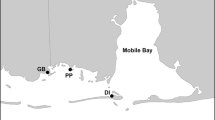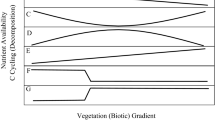Abstract
Salt marshes created on dredge spoil were compared to natural marshes to evaluate the capacity of created marshes to perform carbon cycle functions. Several carbon cycle attributes were measured in eight created Spartina alterniflora Loisel salt marshes that ranged from one to 28 years, each paired with a nearby mature natural reference marsh. The attributes measured included gross primary production, respiration, net ecosystem exchange, potential microbial respiration (CH4 and CO2), and aboveground biomass. In situ exchange rates of CO2 and plant biomass in created marshes met or exceeded those of reference marshes in three to four years. There was some evidence that ecosystem gas exchange in created marshes developed slightly faster than aboveground biomass production. Soil carbon mineralization per gram carbon was generally higher in the created marshes than reference marshes, suggesting higher carbon quality and/or nutrient availability in the created marshes. However, carbon mineralization rates per gram soil were relatively low in the created marshes due to lower soil organic matter content. With proper construction, we suggest most major carbon fluxes can be established in created salt marshes in less than five years.
Similar content being viewed by others
Literature Cited
Boyer, K. E., J. C. Callaway, and J. B. Zedler. 2000. Evaluating the progress of restored cordgrass (Spartina foliosa) marshes: belowground biomass and tissue nitrogen. Estuaries 23(5): 711–21.
Broome, S. W., E. D. Seneca, and W. W. Woodhouse Jr. 1982. Establishing brackish marshes on graded upland sites in North Carolina. Wetlands 2: 152–78.
Broome, S. W., E. D. Seneca, and W. W. Woodhouse Jr. 1986. Long-term growth and development of transplants of the saltmarsh grass Spartina alterniflora. Estuaries 9: 63–74.
Broome, S. W., E. D. Seneca, and W. W. Woodhouse Jr. 1988. Tidal salt marsh restoration. Aquatic Botany 32: 1–22.
Conn, C. E. and F. P. Day Jr. 1997. Root decomposition across a barrier island chronosequence: litter quality and environmental controls. Plant and Soil 195: 351–64.
Craft, C. B. 1997. Dynamics of nitrogen and phosphorous retention during wetland ecosystem succession. Wetlands Ecology and Management 4: 177–87.
Craft, C. B., S. W. Broome, and E. D. Seneca. 1988a. Nitrogen, phosphorous, and organic carbon pools in natural and transplanted marsh soils. Estuaries 11: 272–80.
Craft, C. B., S. W. Broome, E. D. Seneca, and W. J. Showers. 1988b. Estimating sources of soil organic matter in natural and transplanted estuarine marshes using stable isotopes of carbon and nitrogen. Estuarine, Coastal and Shelf Science 26: 633–41.
Craft, C. B., S. W. Broome, and E. D. Seneca. 1989. Exchange of nitrogen, phosphorous, and organic carbon between transplanted marshes and estuarine waters. Journal of Environmental Quality 18: 206–11.
Craft, C., J. Reader, J. N. Sacco, and S. W. Broome. 1999. Twenty-five years of ecosystem development of constructed Spartina alterniflora (Loisel) marshes. Ecological Applications 9: 1405–19.
Craft, C., P. Megonigal, S. Broome, J. Stevenson, R. Freese, J. Cornell, L. Zheng, and J. Sacco. 2003. The pace of ecosystem development of constructed Spartina alterniflora marshes. Ecological Applications 13: 1417–32.
Darke, A. K. and J. P. Megonigal. 2003. Control of sediment deposition rates in two mid-Atlantic coast tidal freshwater wetlands. Estuarine, Coastal and Shelf Science 57: 255–68.
Dayton, P. K., L. A. Levin, T. S. Talley, A. McCray, and A. R. Bustamante. 1996. Early successional measurements in a restored tidal marsh. p. 197–202. Scripps Institution Oceanography, University of California, San Diego, CA, USA.
Haitiner, J., J. B. Zedler, K. E. Boyer, G. D. Williams, and J. C. Callaway. 1997. Influence of physical processes on the design, functioning and evolution of restored tidal wetlands in California (USA). Wetlands Ecology and Management 4: 273–91.
Langis, R., M. Zalejko, and J. B. Zedler. 1991. Nitrogen assessments in a constructed and a natural salt marsh of San Diego Bay. Ecological Applications 1: 40–51.
LaSalle, M. W., M. C. Landin, and J. G. Sims. 1991. Evaluation of the flora and fauna of a Spartina alterniflora marsh established on dredged material in Winyah Bay, South Carolina. Wetlands 11: 191–208.
Megonigal, J. P. and W. H. Schlesinger. 2002. Methane-limited methanotrophy in tidal freshwater swamps. Global Biogeochemical Cycles 16(4), 1088, doi: 10.1029/2001GB001594.
Morris, J. T., P. V. Sundareshwar, C. T. Nietch, B. Kjerfve, and D. R. Cahoon. 2002. Responses of coastal wetlands to rising sea level. Ecology 83: 2869–77.
Neubauer, S. C., W. D. Miller, and I. C. Anderson. 2000. Carbon cycling in a tidal freshwater marsh ecosystem: a carbon gas flux study. Marine Ecology Progress Series 199: 13–30.
Noon, K. F. 1996. A model of created wetland primary succession. Landscape and Urban Planning 34: 97–123.
Odum, E. P. 1969. The strategy of ecosystem development. Science 164: 262–70.
Padgett, D. E. and J. L. Brown. 1999. Effects of drainage and soil organic content on growth of Spartina alterniflora (Poaceae) in an artificial salt marsh mesocosm. American Journal of Botany 86: 697–702.
Poach, M. E. and S. P. Faulkner. 1998. Soil phosphorous characteristics of created and natural wetlands in the Atchafalaya Delta, LA. Estuarine, Coastal and Shelf Sciences 46: 195–203.
Radford, A. E., H. E. Ahles, and C. R. Bell. 1968. Manual of the vascular flora of the Carolinas. The University of North Carolina Press, Chapel Hill, NC, USA.
SAS. 1990. SAS/STAT User’s Guide, version 6. SAS Institute, Cary, NC, USA.
Segel, I. H. 1976. Biochemical Calculations: How to Solve Mathematical Problems in General Biochemistry. John Wiley & Sons, Inc., New York, NY, USA.
Seneca, E. D., S. W. Broome, and W. W. Woodhouse Jr. 1985. Comparison of Spartina alterniflora Loisel. transplants from different locations in a man-initiated marsh in North Carolina. Wetlands 5: 181–90.
Shafer, D. J. and W. J. Streever. 2000. A comparison of 28 natural and dredged material salt marshes in Texas with an emphasis on geomorphological variables. Wetlands Ecology and Management 8: 353–66.
Sokal, R. R. and F. J. Rohlf. 1981. Biometry, second edition. W. H. Freeman and Company, San Francisco, CA, USA.
Streever, W. J. 2000. Spartina alterniflora marshes on dredged material: a critical review of the ongoing debate over success. Wetlands Ecology and Management 8: 295–316.
Ward, K. M., J. C. Callaway, and J. B. Zedler. 2003. Episodic colonization of an intertidal mudflat by native cordgrass (Spartina foliosa) at Tijuana Estuary. Estuaries 26(1): 116–30.
White, D. S. and B. L. Howes. 1994. Nitrogen incorporation into decomposing litter of Spartina alterniflora. Limnology and Oceanography 39: 133–40.
Zedler, J. B. and J. C. Callaway. 2000. Evaluating the progress of engineered tidal wetlands. Ecological Engineering 15(3-4): 211–25.
Author information
Authors and Affiliations
Corresponding author
Rights and permissions
About this article
Cite this article
Cornell, J.A., Craft, C.B. & Megonigal, J.P. Ecosystem gas exchange across a created salt marsh chronosequence. Wetlands 27, 240–250 (2007). https://doi.org/10.1672/0277-5212(2007)27[240:EGEAAC]2.0.CO;2
Received:
Revised:
Accepted:
Issue Date:
DOI: https://doi.org/10.1672/0277-5212(2007)27[240:EGEAAC]2.0.CO;2




